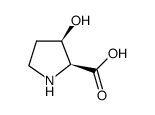Novel proline hydroxylase activities in the pneumocandin-producing fungus Glarea lozoyensis responsible for the formation of trans 3- and trans 4-hydroxyproline.
L Petersen, R Olewinski, P Salmon, N Connors
文献索引:Appl. Microbiol. Biotechnol. 62(2-3) , 263-7, (2003)
全文:HTML全文
摘要
Novel proline 3-hydroxylase (P3H) and proline 4-hydroxylase (P4H) activities that convert free l-proline to both trans 3- and trans 4-hydroxy- l-proline were detected in protein extracts of the anamorphic fungus Glarea lozoyensis. The enzymatic conversion of l-proline to trans 3- and trans 4-hydroxy- l-proline was strictly dependent on alpha-ketoglutarate, ascorbate, and dithiothreitol. Ferrous iron was required for optimal P3H and P4H activity. These substrate and co-factor requirements indicate these enzyme activities belong to the class of 2-oxoglutarate-dependent dioxygenases. Both P3H and P4H were inhibited by zinc and other trace metals. The addition of proline to the fermentation medium resulted in an increase in the specific activity of P4H and a decrease in the synthesis of pneumocandin C(0). Additionally, the synthesis of trans 3- and trans 4-hydroxy- l-proline in vivo was affected differently by the proline concentration in the medium. This result suggested that two enzymes may be responsible for the regio- and stereospecific hydroxylation of l-proline.
相关化合物
| 结构式 | 名称/CAS号 | 分子式 | 全部文献 |
|---|---|---|---|
 |
cis-3-hydroxy-L-proline
CAS:4298-05-9 |
C5H9NO3 |
|
Insights on the evolution of prolyl 3-hydroxylation sites fr...
2011-01-01 [PLoS ONE 6(5) , e19336, (2011)] |
|
Conformational studies of peptides containing cis-3-hydroxy-...
2004-10-15 [J. Org. Chem. 69(21) , 7399-402, (2004)] |
|
Pneumocandins from Zalerion arboricola. V. Glutamic acid- an...
1992-12-01 [J. Antibiot. 45(12) , 1953-7, (1992)] |
|
Identification of 3-hydroxyproline residues in several prote...
1996-01-01 [Exp. Parasitol. 82(1) , 69-72, (1996)] |
|
Separation and evaluation of the cis and trans isomers of hy...
1984-02-01 [Anal. Biochem. 137(1) , 151-5, (1984)] |